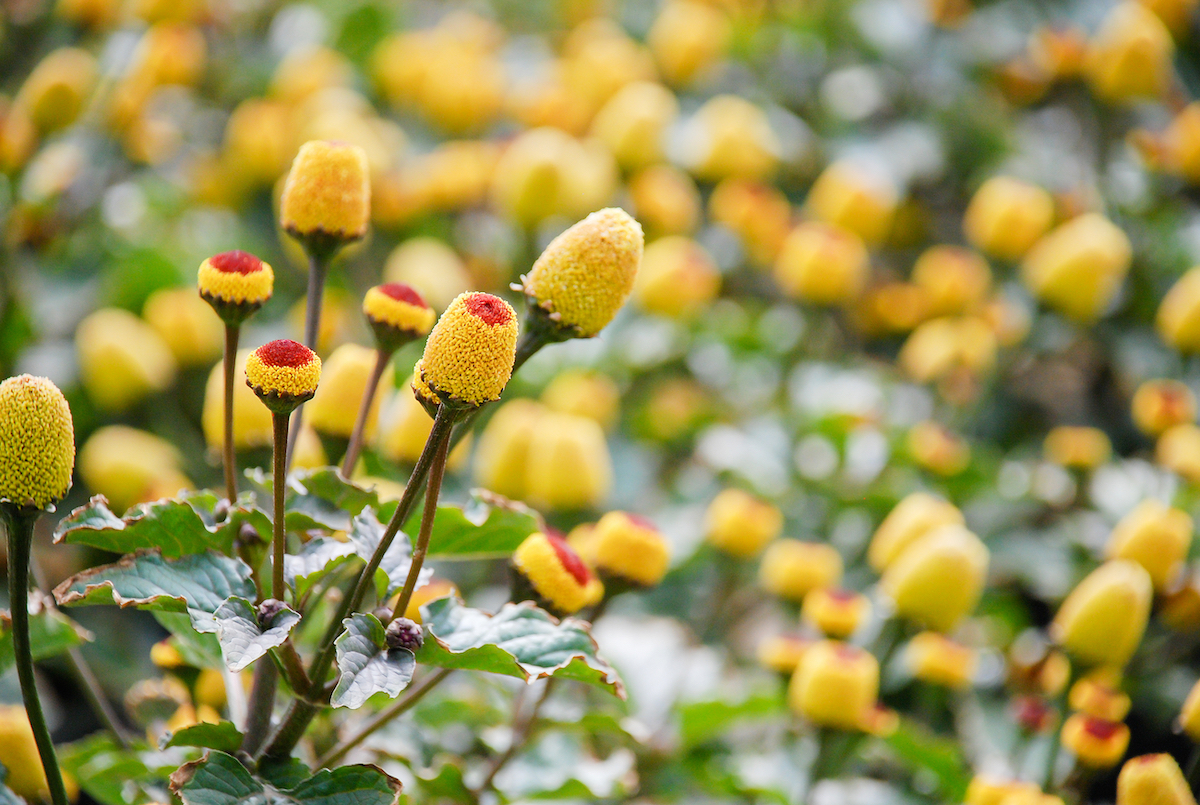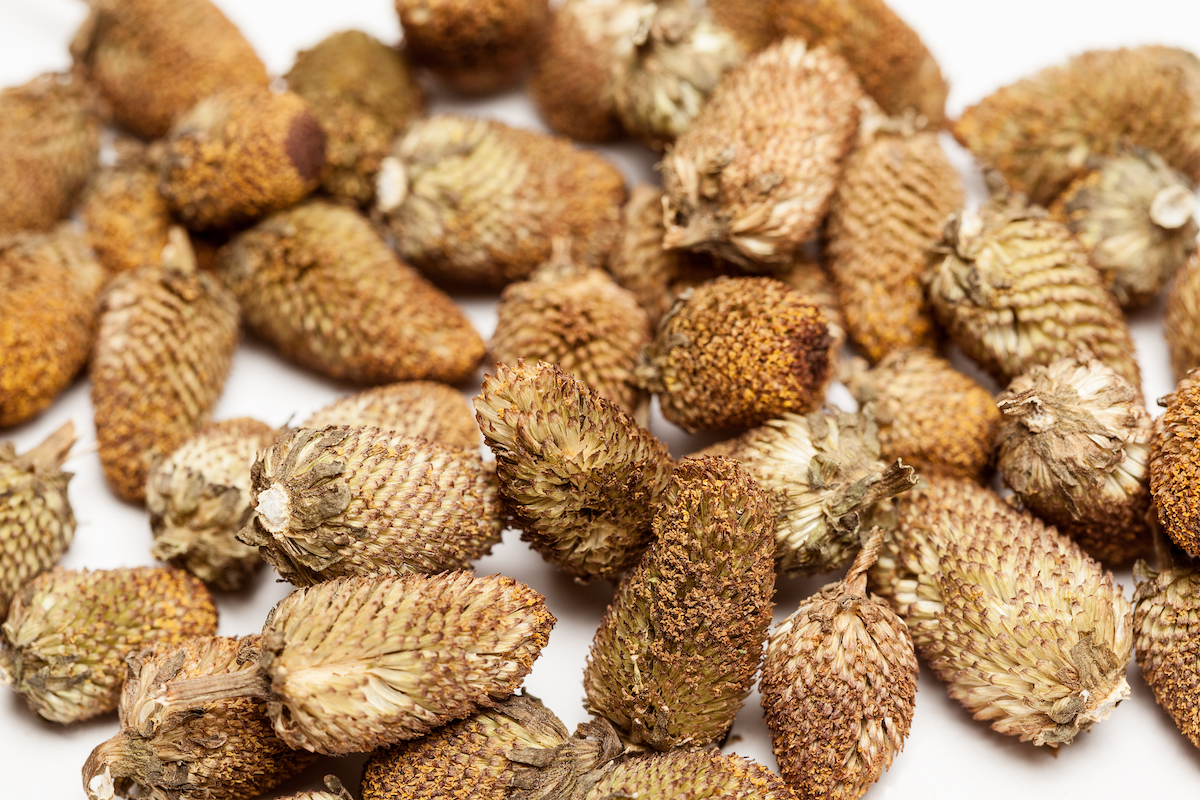- For most people, the best way to know a plant is by its popular name.
- Terms like ‘jambu’ or ‘Sichuan button’ might not mean much, but more attractive names such as ‘toothache plant’ or ‘electric daisy’ will catch people’s attention straightaway.
- The plant christened with such odd names is Acmella oleracea; it has become a popular garden plant in the last few years, but it also showcases remarkable recreational and therapeutic properties.

Acmella oleracea, also known as Spilanthes oleracea, is a plant that has been part of the traditional culture of many tropical areas, and has been used for both mundane and spiritual applications. It has found a place in kitchens worldwide due to its characteristic intense, pungent flavour. It is often consumed as a tea but also as a seasoning in dishes from communities in northern Brazil, in salads in the USA, or even added to steamed vegetables, soups and meats in India.
Even though it is mainly used as an ornamental plant, many ancient American native people used it in religious celebrations and mainly as a local anaesthetic. Its flowers and leaves produce a tingling sensation on the lips and tongue that 'electrifies' and 'numbs' the palate; hence its name 'electric daisy' or 'toothache plant', as it was traditionally used to alleviate toothache.
Taxonomy and description
Acmella oleracea is native to Brazil and Peru, though nowadays it grows wild in the tropical areas in the Southern Hemisphere and in the warmest areas of Asia, where it was probably originally introduced by Portuguese seamen. It looks like a petalless daisy or camomile flower, which is not surprising as all of these, together with sunflowers, belong to the Asteraceae family.
The Acmella oleracea plant is small in size. It exhibits a dark green stem and conical leaves of the same colour. Its flowers are pompom-shaped and start off all red. As they grow they stay red in the centre and the rest turns yellow, resembling an eye (for this reason it is also known as the 'eye ball plant').

Culinary uses
Acmella oleracea's popularity is undoubtedly owed to its use in the kitchen. It is an edible plant whose numbing effect does not strike until a few minutes after ingestion. When chewed, its flavour is acidic, and is followed by a mouth-watering sensation. The mouth gradually becomes numb in some areas, but the salivating does not stop. This is why some famous chefs are introducing it in some of their dishes because they believe that its mouth-watering effect enhances flavour and improves taste.
In its dehydrated form, it is known as 'Sichuan pepper', and is used instead of salt to sprinkle over gazpacho soup, meat and fish dishes. It is even used to decorate and complement cocktails, such as gin and tonic. It provides a refreshing flavour, giving dishes an original touch and unique sensation. For those who love spicy food, the 'electric daisy' is a good mouth-numbing remedy as opposed to 'off-the-chart' chilli peppers.
Medical use
In addition to its potent mouth-watering effect, this plant is an effective anaesthetic. This is due to its main active ingredient, Spilanthol, which is found in the flowers, leaves and roots of many plants, and has been known for its analgesic properties since the 1950s. This compound produces a pronounced local tingling feeling (hence its name 'electric') along with a numbing and refreshing effect. This is the reason why the indigenous people of the Amazon use it as an anaesthetic for the treatment of sores, herpes, toothache, and sore throats.
Acmella oleracea also works as a fungicide and is a good fighter against ticks. It has also awakened the interest of some scientists for the development of certain drugs. In addition, it is also used in beauty products, such as anti-wrinkle creams, and as an ingredient in natural intimate lubricants.

If you are interested in planting Acmella oleracea…
- It requires warm climates, full exposure to sun or partial shade, and high moisture levels. It cannot stand low temperatures, let alone frost.
- It needs nutrient-rich soil that can absorb and retain moisture, but must also be well-drained.
- It requires constant watering but without this becoming excessive. The soil must be kept moist so you need to keep an eye on it at all times.
- Seeds must be sown on top of the substrate and must be kept uncovered, as they need sunlight to germinate, at a temperature between 20 and 24°C.
- Sow in early summer (from May). Depending on the latitude, it can also be sown in spring.
- The best time for harvest is late summer, which coincides with the maximum flowering time.
----
References:
- Spilanthol: occurrence, extraction, chemistry and biological activities. Alan F. Barbosa, Mário G. de Carvalho, Robert E. Smith, Armando U.O. Saba-Srur. Revista Brasileira de Farmacognosia. 2017



Comments from our readers
There are no comments yet. Would you like to be the first?
Leave a comment!Did you like this post?
Your opinion about our seeds is very important to us and can help other users a lot (your email address won't be made public).